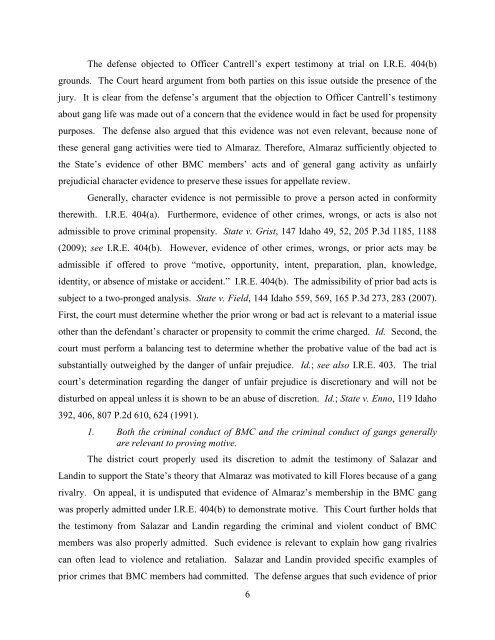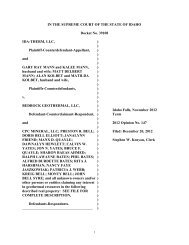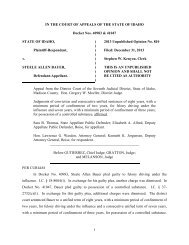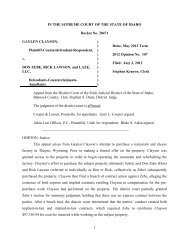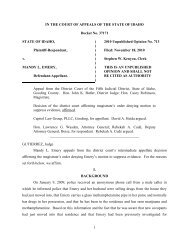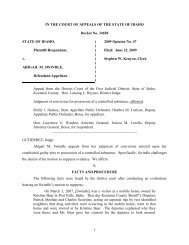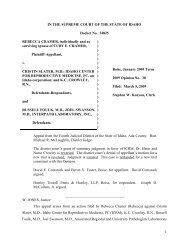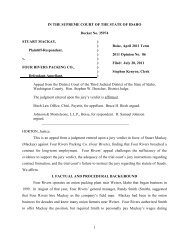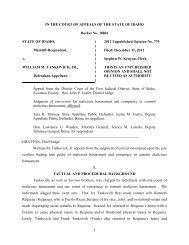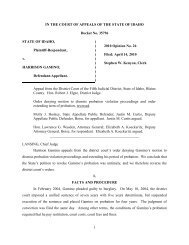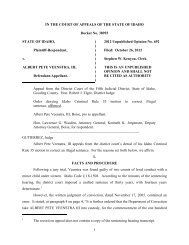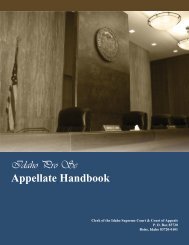April 1, 2013 State v. Hector B. Almaraz, Jr. - Idaho State Judiciary
April 1, 2013 State v. Hector B. Almaraz, Jr. - Idaho State Judiciary
April 1, 2013 State v. Hector B. Almaraz, Jr. - Idaho State Judiciary
Create successful ePaper yourself
Turn your PDF publications into a flip-book with our unique Google optimized e-Paper software.
The defense objected to Officer Cantrell’s expert testimony at trial on I.R.E. 404(b)<br />
grounds. The Court heard argument from both parties on this issue outside the presence of the<br />
jury. It is clear from the defense’s argument that the objection to Officer Cantrell’s testimony<br />
about gang life was made out of a concern that the evidence would in fact be used for propensity<br />
purposes. The defense also argued that this evidence was not even relevant, because none of<br />
these general gang activities were tied to <strong>Almaraz</strong>. Therefore, <strong>Almaraz</strong> sufficiently objected to<br />
the <strong>State</strong>’s evidence of other BMC members’ acts and of general gang activity as unfairly<br />
prejudicial character evidence to preserve these issues for appellate review.<br />
Generally, character evidence is not permissible to prove a person acted in conformity<br />
therewith. I.R.E. 404(a). Furthermore, evidence of other crimes, wrongs, or acts is also not<br />
admissible to prove criminal propensity. <strong>State</strong> v. Grist, 147 <strong>Idaho</strong> 49, 52, 205 P.3d 1185, 1188<br />
(2009); see I.R.E. 404(b). However, evidence of other crimes, wrongs, or prior acts may be<br />
admissible if offered to prove “motive, opportunity, intent, preparation, plan, knowledge,<br />
identity, or absence of mistake or accident.” I.R.E. 404(b). The admissibility of prior bad acts is<br />
subject to a two-pronged analysis. <strong>State</strong> v. Field, 144 <strong>Idaho</strong> 559, 569, 165 P.3d 273, 283 (2007).<br />
First, the court must determine whether the prior wrong or bad act is relevant to a material issue<br />
other than the defendant’s character or propensity to commit the crime charged. Id. Second, the<br />
court must perform a balancing test to determine whether the probative value of the bad act is<br />
substantially outweighed by the danger of unfair prejudice. Id.; see also I.R.E. 403. The trial<br />
court’s determination regarding the danger of unfair prejudice is discretionary and will not be<br />
disturbed on appeal unless it is shown to be an abuse of discretion. Id.; <strong>State</strong> v. Enno, 119 <strong>Idaho</strong><br />
392, 406, 807 P.2d 610, 624 (1991).<br />
1. Both the criminal conduct of BMC and the criminal conduct of gangs generally<br />
are relevant to proving motive.<br />
The district court properly used its discretion to admit the testimony of Salazar and<br />
Landin to support the <strong>State</strong>’s theory that <strong>Almaraz</strong> was motivated to kill Flores because of a gang<br />
rivalry. On appeal, it is undisputed that evidence of <strong>Almaraz</strong>’s membership in the BMC gang<br />
was properly admitted under I.R.E. 404(b) to demonstrate motive. This Court further holds that<br />
the testimony from Salazar and Landin regarding the criminal and violent conduct of BMC<br />
members was also properly admitted. Such evidence is relevant to explain how gang rivalries<br />
can often lead to violence and retaliation. Salazar and Landin provided specific examples of<br />
prior crimes that BMC members had committed. The defense argues that such evidence of prior<br />
6


